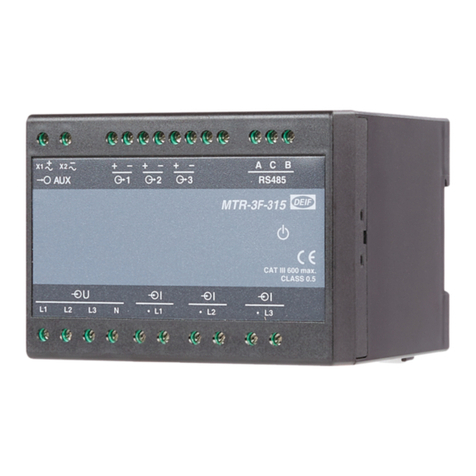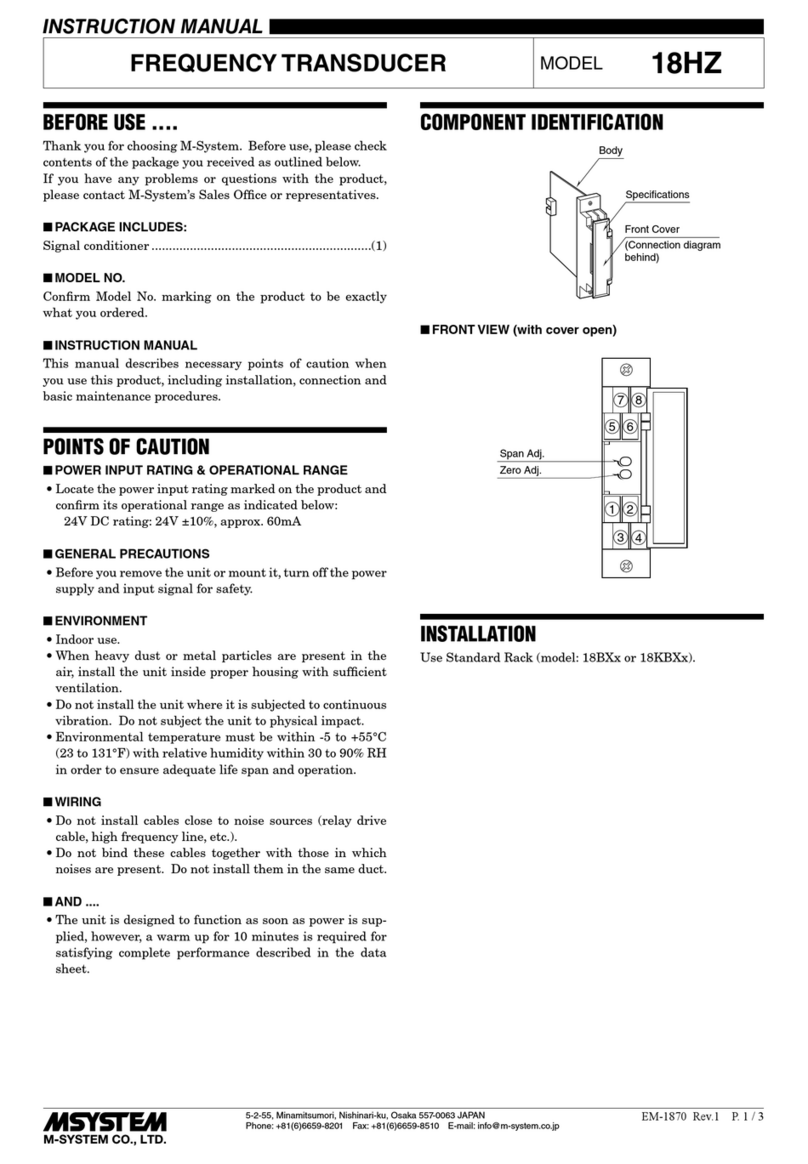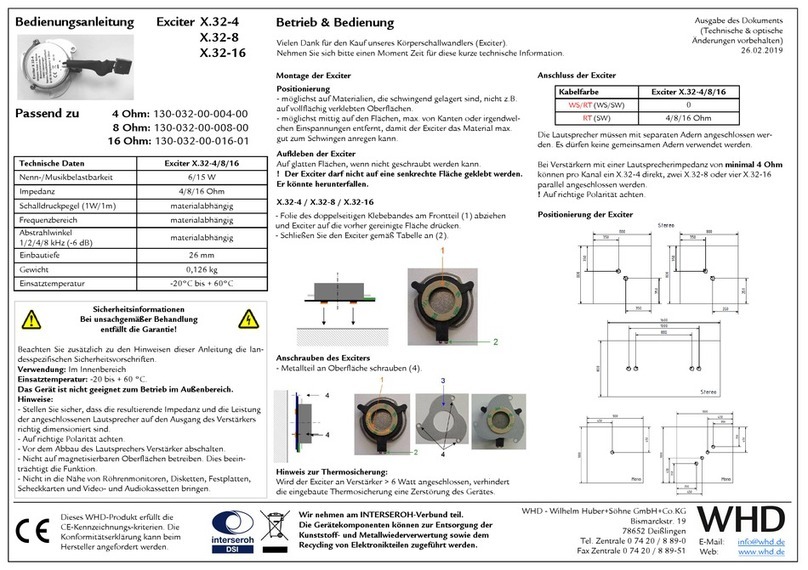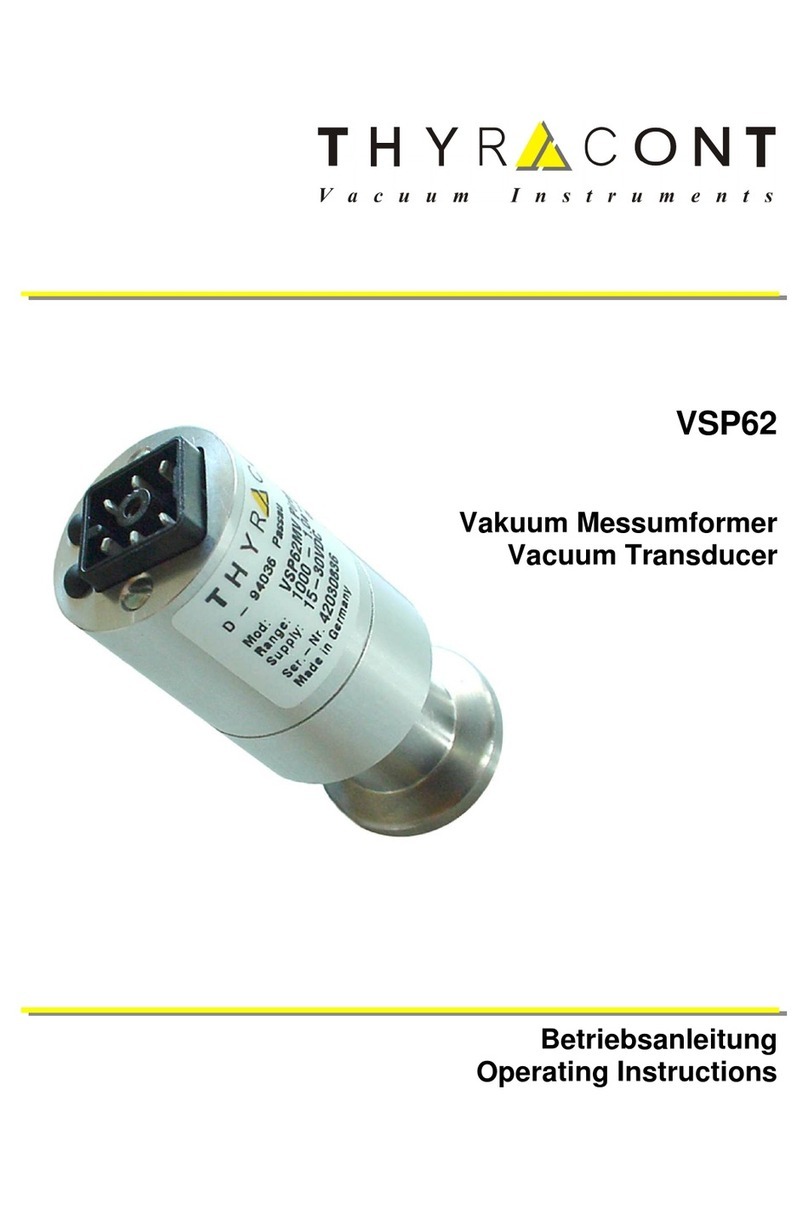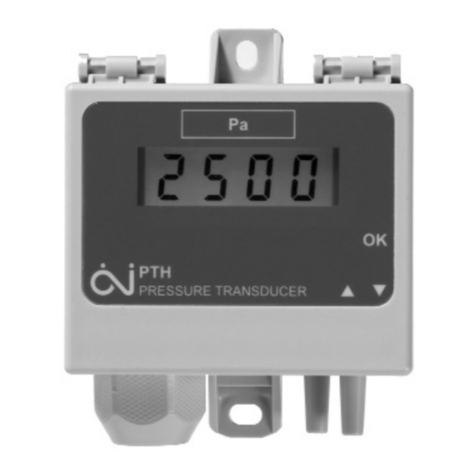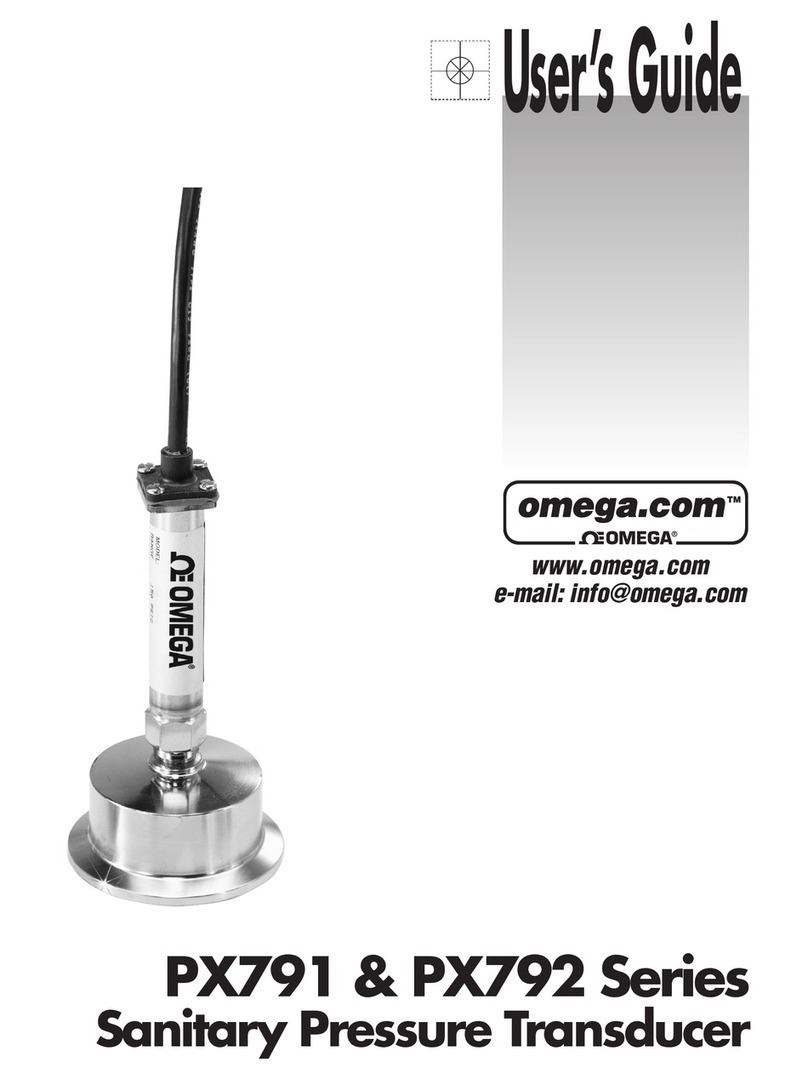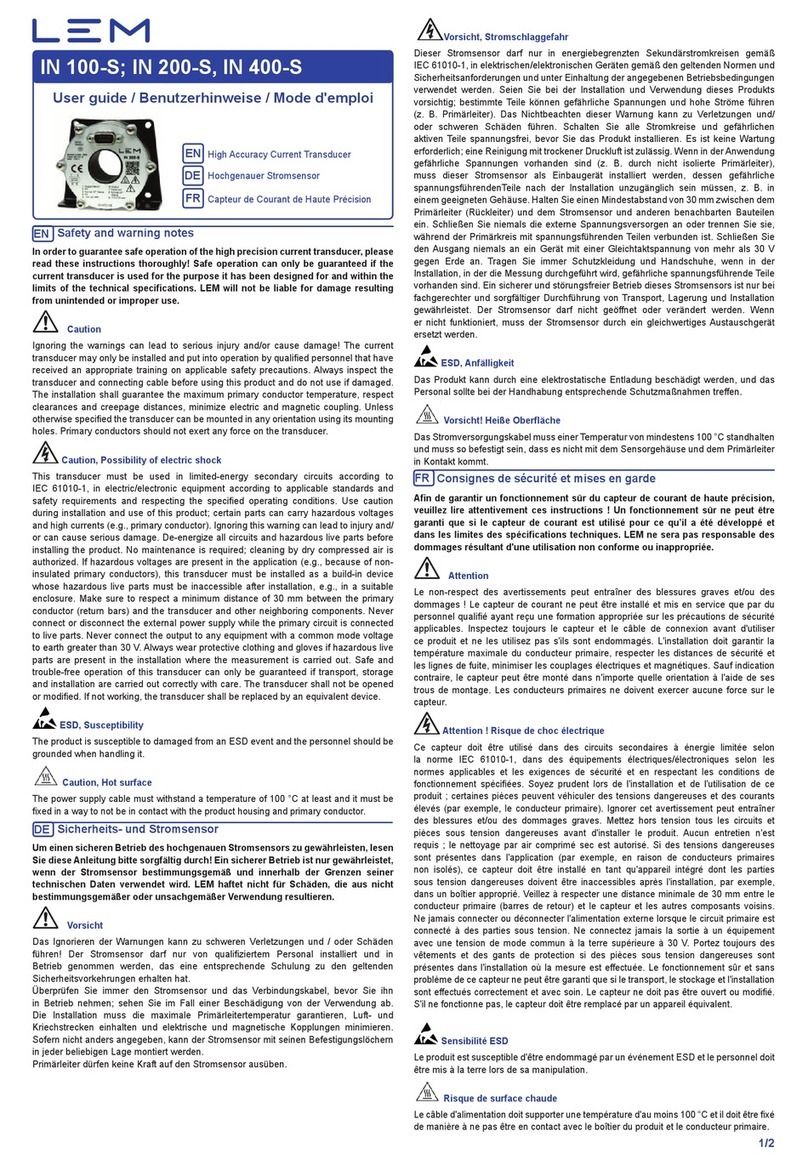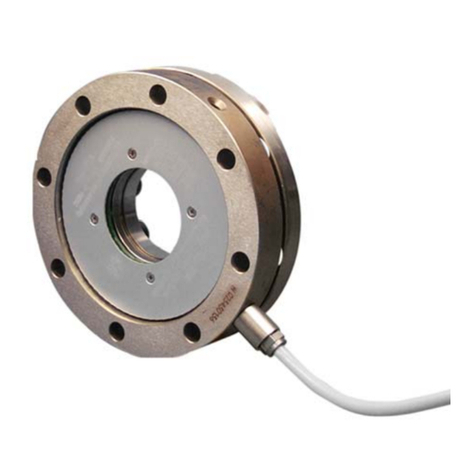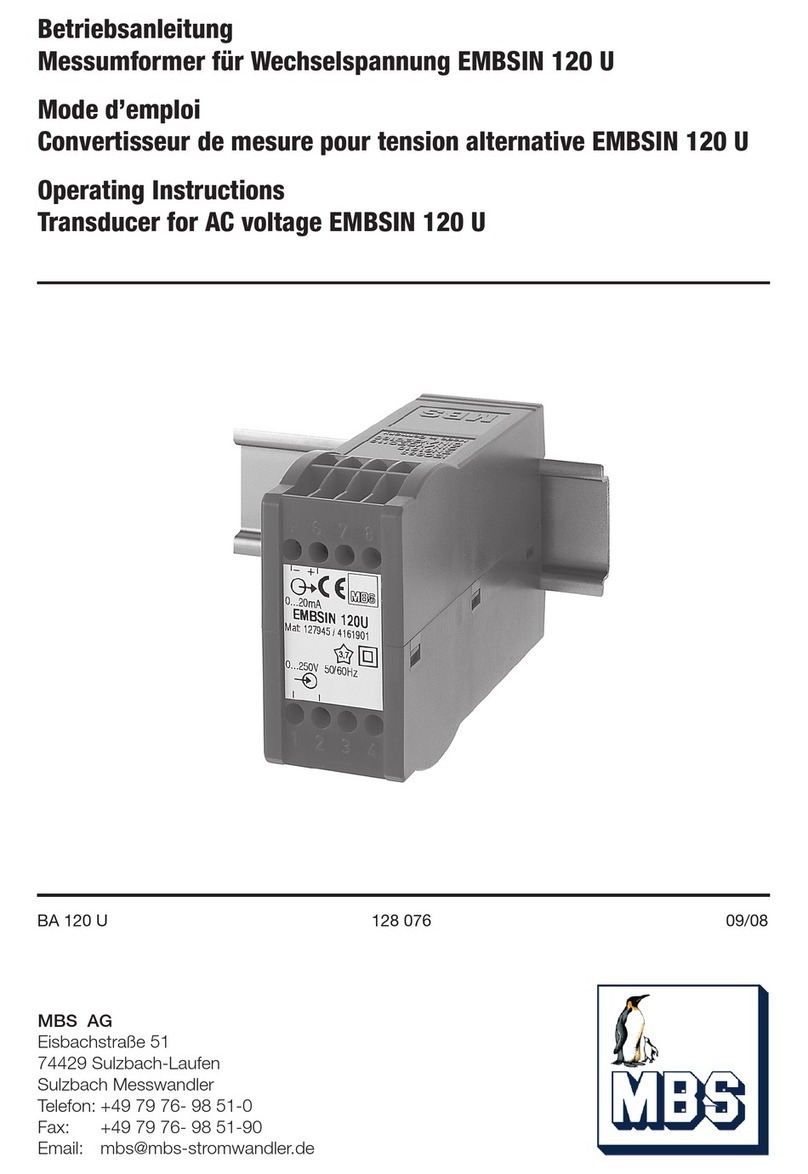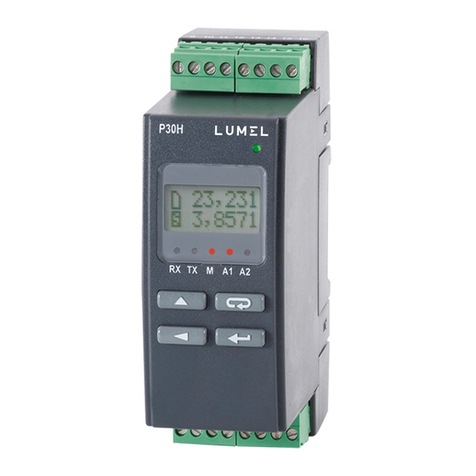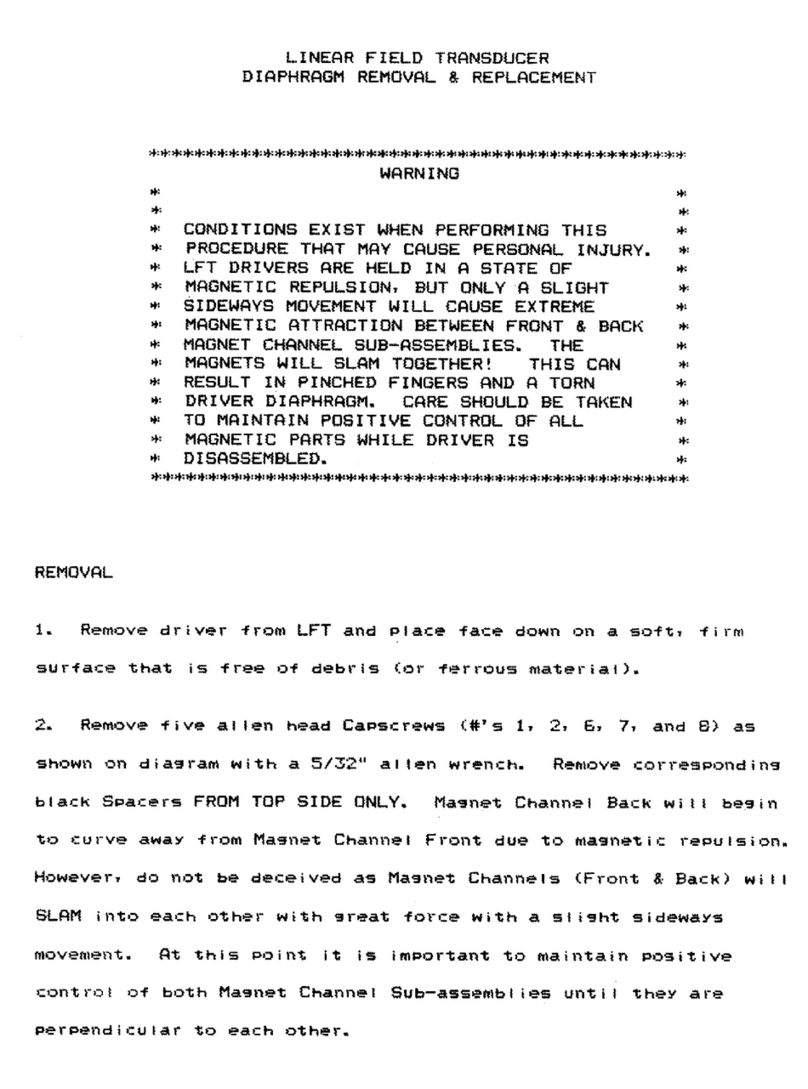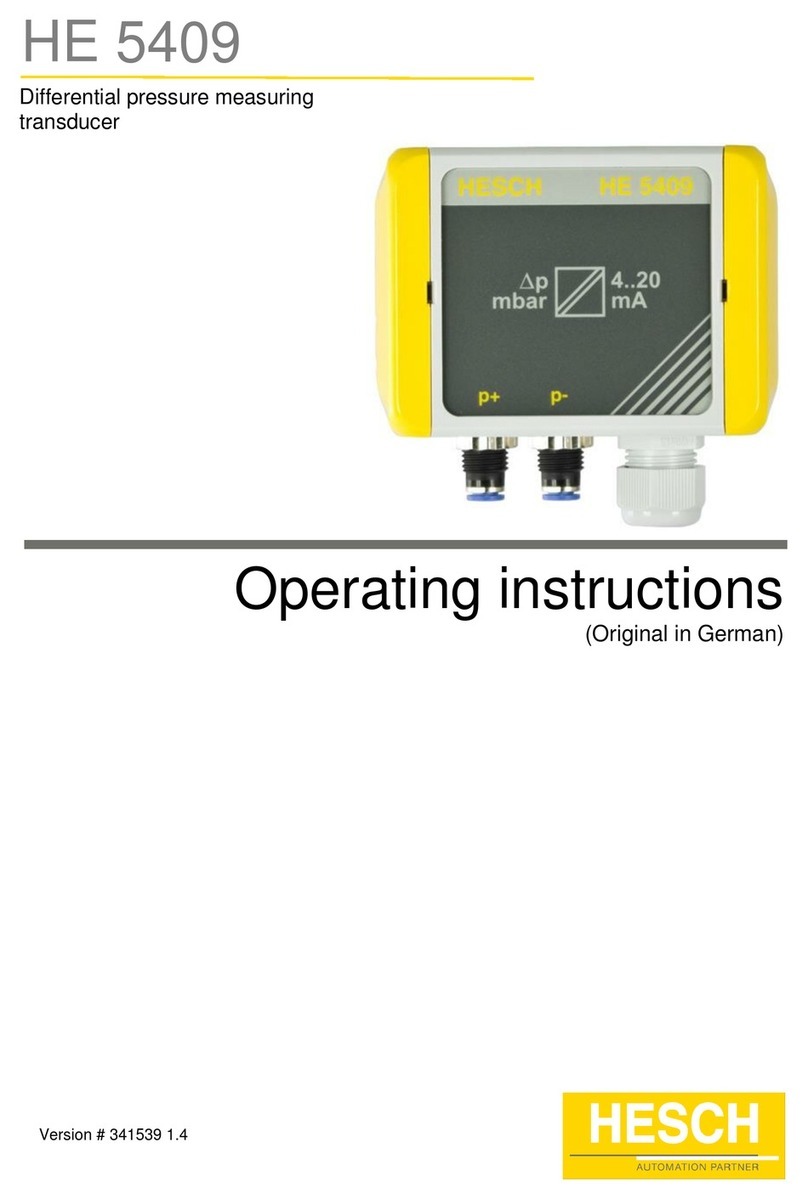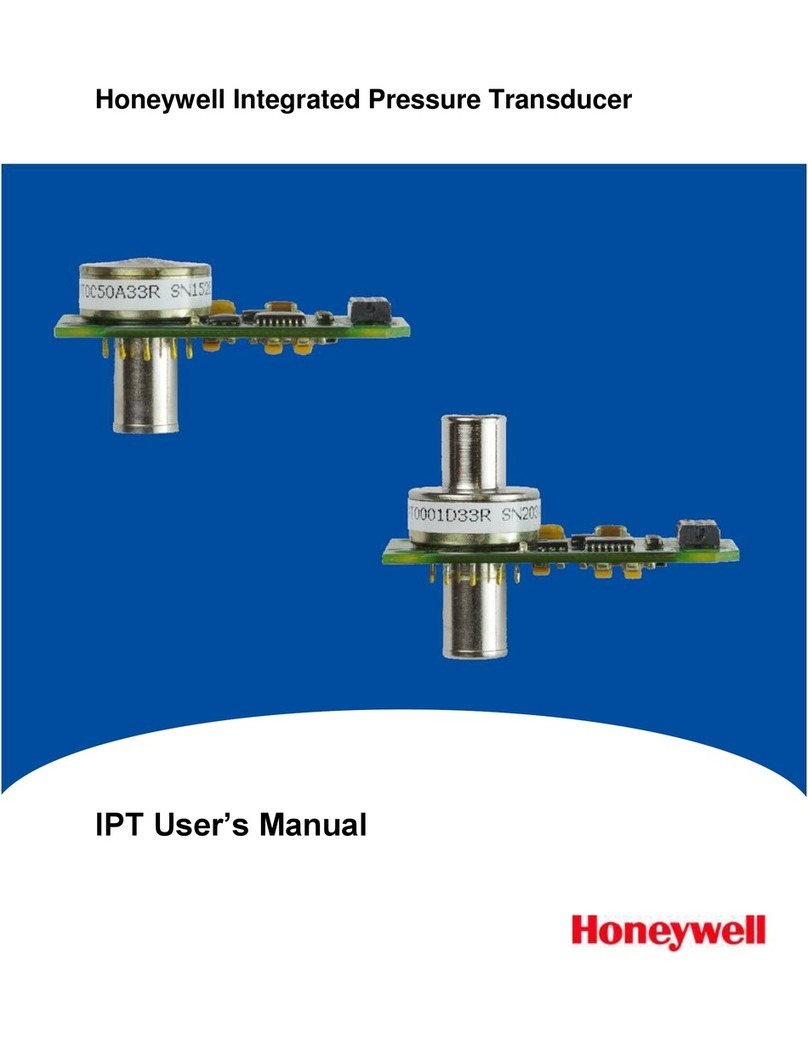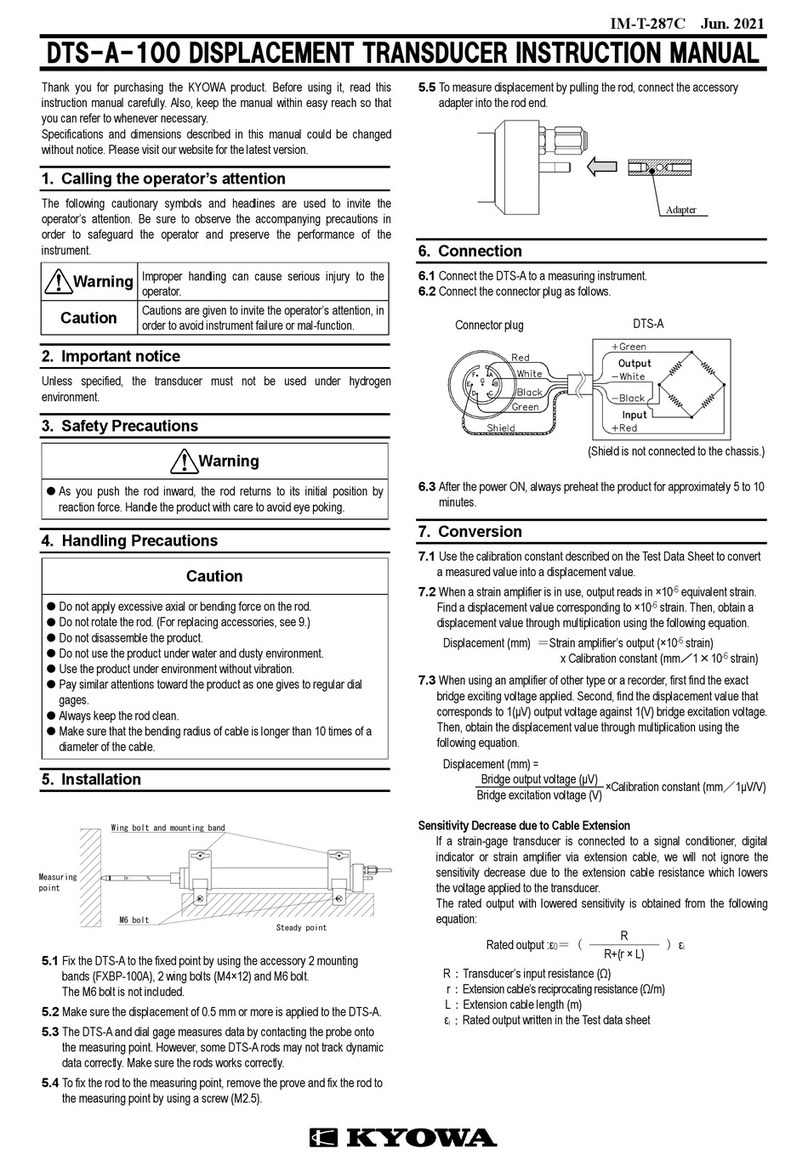Interface T2 User manual

T2, T3, T4, T5, T6, T7, T12 & T15
Rotary Torque Transducers
Operation Manual
T2 Precision Rotary &
T4 General Purpose Rotary
Torque Transducers
T6 Dual Range
Rotary Torque Transducer
T3 Precision Rotary &
T5 General Purpose Rotary
Torque Transducers
T7 Dual Range
Rotary Torque Transducer T12 Square Drive
Rotary Torque Transducer T15 Hex Drive
Rotary Torque Transducer
7401 East Butherus Drive • Scottsdale, Arizona 85260 • 480.948.5555 • www.interfaceforce.com

Valid for... T2, T3, T4, T5, T6, T7, T12 & T15 Rotary Torque
Copyright © 2009 Interface, Inc.
Modification Technical changes reserved.
References in this Text
1.6 Warning Notes; Page 5
Attention must be paid to the accident prevention regulations of the trade associations.
Coverings and casings are necessary before operating the transducer. This is also valid for commissioning,
maintenance and troubleshooting.
Duties of the coverings and casings are:
⇒Protection from detaching parts
⇒Protection from contusion and shear
⇒Prevention from reaching rotating parts
⇒Prevention from being tangled up and/or getting caught by parts
Coverings may:
⇒Not grind
⇒Not rotate
Coverings are also necessary outside of operating and motion travel areas of persons.
These demands can be modified if other sufficient safety devices are available. During operation, the safety
precautions must be operative. By vibrations, damages can occur on the device.
5 Mechanical Assembly; Page 10
During the assembly, the transducer must be supported to protect it from falling down.
5.1.3 Alignment of the Measurement Arrangement; Page 10
For more information please consult factory for details. (800) 947-5598 | (480) 948-5555 or visit
www.interfaceforce.com.
5.2 General; Page 10
Before the assembly, shafts must be cleaned with dissolver (i.e. acetone), no foreign particles may adhere to
them. The hub must fit corresponding to the connection.
Caution: During the assembly inadmissibly large forces may not act on the transducer or the couplings. At small
torques
(< 20 Nm) connect the transducer electrically during the assembly and observe the signal, the measurement
signal may not exceed the limit values.
5.2.1 Torque Transducers of 0.03 Nm to 15 Nm; Page 11
Transducers with nominal torques below 20 Nm are very sensitive to overload, therefore these transducers
need to be handled with greatest caution.
5.3 Free floating Assembly; Page 11
Caution: During the assembly inadmissibly large forces may not act on the transducer or the couplings.
In this installation case, double-jointed couplings cannot be used for both sides.
Risk of Breakage!
5.4 Foot Version Assembly; Page 12
6.1 Engaging; Page 13
6.4.2 Natural Resonances; Page 14
An operation of the device in natural resonance can lead to permanent damages.
Warming-up period of the torque transducer is approx. 5 min.
Caution: During the assembly inadmissibly large forces may not act on the transducer or the couplings.
7401 East Butherus Drive • Scottsdale, Arizona 85260 • 480.948.5555 • www.interfaceforce.com

1
1.1
1.2
1.3
1.3.1
1.3.2
1.4
1.5
1.6
2
2.1
2.2
3
3.1
3.2
3.2.1
3.2.2
3.2.3
4
4.1
4.2
4.2.1
4.2.2
4.3
4.4
4.5
4.6
4.7
5
5.1
5.1.1
5.1.2
5.1.3
5.2
5.2.1
5.2.2
5.3
5.4
5.5
6
6.1
6.2
6.3
6.4
6.4.1
6.4.2
6.5
6.6
7
7.1
7.2
8
9
9.1
9.2
10
11
11.1
11.2
11.3
Read First……………………………………………………………………………………………………………………...
Safety and Caution Symbols………………………………….……………………………………………………………..
Intended Use………………………………………………………………………………………………………………......
Dangers……………………………………………………………………………………………………………………......
Neglecting of Safety Notes………………………………………………………………………………………………......
Remaining Dangers………………………………………………………………………………………………………......
Reconstructions and Modifications…………………………..…………………………………………………………......
Personnel……………………………………………………….…………………………………………………………......
Warning Notes………………………………………………….…………………………………………………………......
Term Definitions………………………………………………..…………………………………………………………......
Terms………………………………………………………………………………………………………………………......
Definition of the Pictograms on the Torque Tranducer…….…………………………………………………………......
Product Description…………………………………………….………………………………………………………….....
Mechanical Setup…………………………………………………………………………………………………………......
Principle of Operation………………………………………….…………………………………………………………......
Electrical Setup……………………………………………………………………………………………………………......
Transducers with Analog Output……………………………..…………………………………………………………......
Transducers with RS485 Interface…………………………...…………………………………………………………......
The Serial Communication………………………………………………………………………………………………......
Electrical Connection…………………………………………..…………………………………………………………......
Pin Connection……………………………………………………………………………………………………………......
Calibration Control……………………………………………..…………………………………………………………......
Calibration Control and Analog Output…………………………………………………………………………………......
Calibration Control at RS485………………………………….………………………………………………………….....
Cable…………………………………………………………….…………………………………………………………......
Shielding Connection…………………………………………..………………………………………………………….....
Running of Measuring Cables………………………………...………………………………………………………….....
Angle/Speed (Option) ……………………………………………………………………………………………………......
Speed Only (Option) …………………………………………..…………………………………………………………......
Mechanical Assembly………………………………………….…………………………………………………………......
Couplings………………………………………………………..………………………………………………………….....
Misalignment Possibilities of Single-Jointed Couplings………………………………………………………………......
Double-Jointed Couplings……………………………………..………………………………………………………….....
Alignment of the Measurement Arrangement……………….…………………………………………………………......
General………………………………………………………….…………………………………………………………......
Torque Transducers of 0.03 Nm to 15 Nm………………….…………………………………………………………......
Torque Transducers from 20 Nm…………………………….…………………………………………………………......
Freefloating Assembly……………………………………………………………………………………………………......
Foot Version Assembly………………………………………..…………………………………………………………......
Typical Application…….……………………………………….…………………………………………………………......
Measuring……………………………………………………….…………………………………………………………......
Engaging………………………………………………………..…………………………………………………………......
Direction of Torque…………………………………………….…………………………………………………………......
Static/Quasi-Static Torques…………………………………...………………………………………………………….....
Dynamic Torques…………………………………………………………………………………………………………......
General………………………………………………………….…………………………………………………………......
Natural Resonances…………………………………………...…………………………………………………………......
Speed Limits………………………………………………………………………………………………………………......
Disturbance Variables……………………………………………………………………………………………………......
Maintenance…………………………………………………….………………………………………………………….....
Maintenance Schedule………………………………………...………………………………………………………….....
Troubleshooting………………………………………………...………………………………………………………….....
Decommssion…………………………………………………..…………………………………………………………......
Transportation and Storage…………………………………...………………………………………………………….....
Transportation…………………………………………………..………………………………………………………….....
Storage………………………………………………………….…………………………………………………………......
Disposal……………………………………………………………………………………………………………………......
Calibration…………………………………………………………………………………………………………………......
Proprietary Calibration……………………………………………………………………………………………………......
DKD-Calibration………………………………………………..…………………………………………………………......
Recalibration………………………………………………………………………………………………………………......
4
4
4
4
4
4
4
4
5
5
5
5
5
5
6
7
8
8
8
8
8
8
9
9
9
9
9
9
9
10
10
10
10
10
10
11
11
11
12
13
13
13
13
13
13
13
14
14
14
14
14
15
15
15
15
16
16
16
16
16
16
CONTENTS
7401 East Butherus Drive • Scottsdale, Arizona 85260 • 480.948.5555 • www.interfaceforce.com

1Read First
1.1 Safety and Caution Symbols
Note:
Important points to be considered.
Caution:
Injury Risk for Persons
Damage of the Device is possible.
1.2 Intended Use
Torque transducers are intended for the measurement of torques. This measure is further suitable for control tasks. The valid
safety regulations should be absolutely respected. The torque transducers are not safety components in the sense of the
intended use. The transducers need to be transported and stored appropriately. The assembly, commissioning and
disassembling must take place professionally.
1.3 Dangers
The torque transducer is fail-safe and corresponds to the state of technology.
1.3.1 Neglecting of Safety Notes
At inappropriate use, remaining dangers can emerge (i.e. by untrained personnel). The operation manual must be read and
understood by each person entrusted with the assembly, maintenance, repair, operation and disassembly of the torque
transducer.
1.3.2 Remaining Dangers
The plant designer, the supplier, as well as the operator must plan, realize and take responsibility for safety-related interests for
the transducer. Remaining dangers must be minimized. Remaining dangers of the torque measurement technique must be
pointed out.
Human mistakes must be considered. The construction of the plant must be suitable for the avoidance of dangers. A danger-
analysis for the plant must be carried out.
1.4 Reconstructions and Modifications
Each modification of the transducers without our written approval excludes liability on our part.
1.5 Personnel
4
7401 East Butherus Drive • Scottsdale, Arizona 85260 • 480.948.5555 • www.interfaceforce.com

2Term Definitions
2.1 Terms
Measuring Side:
Mechanical connection of the torque transducer in which the torque to be measured is applied. Usually this side has the smallest
moment of inertia.
Drive Side:
Mechanical connection of the torque transducer on the opposite side of the measuring side, usually with the largest moment of
inertia. At static torque transducers the housing is fastened on this side.
Low Torque Resistance Side:
The shaft of the arrangement (drive, load) which can be turned considerably smaller with torque than the nominal torque of the
torque transducer M << Mnenn.
2.2 Definition of the Pictograms on the Torque Transducer
The measuring side of the torque transducer is designated as follows:
Measuring side: or M
For more information consult factory (800) 947-5598 or visit www.interfaceforce.com
3Product Description
The transducer measures static and dynamic torques. The mounting position of the torque transducer is horizontally.
Caution: It is differentiated between measuring side and driving side. Consult factory for details.
3.1 Mechanical Setup
The transducers consist of a torsion shaft. Depending on design, the mechanical connection possibilities are executable with
round shafts or feather key connections etc. The torsion shaft, applied with two strain gauge full bridges, is bedded in a housing
through ball bearings. For the signal transmission and/or the supply of the strain gauge full bridges, a rotating transformer,
according to the principle of a transformer, is arranged in the transducer. For supply and measuring signal conditioning,
electronics are integrated in the stator and the rotor.
M
5
7401 East Butherus Drive • Scottsdale, Arizona 85260 • 480.948.5555 • www.interfaceforce.com

3.2 Principle of Operation
The supply voltage of between 12 and 28V DC is converted to AC in the stator and transferred inductively to the rotor
electronics. The voltage is rectified and stabilized and fed to the strain gage bridge. The output of the bridge is conditioned in an
amplifier and then converted to a digital signal, which is transferred to the stator by another rotating transformer. This digital
signal is much more disturbance-free than an analog signal and is highly immune to noise. This signal is further conditioned in
the stator, comes into a µ-processor and then is converted to the ±5 or ±10V output signal.
These transducers feature internal Shunt Calibration Resistors that can be switched into the bridge. A voltage of greater than
3.5V to pin K causes a control signal to be up-modulated to the supply voltage and transferred to the rotor. There, it is filtered
and evaluated by the µPC, which then activates the internal switch for the connection of the R-Cal resistor.
Initial Calibration
1. A preliminary calibration of the strain gaged shaft determines the bridge full scale output in mV/V.
2. A shunt resistor value is created to provide an output equal to the full scale output of the strain gage bridge.
3. The resistor is then hard-wired through a switch into the bridge.
4. Final assembly includes installation of the rotating shaft into the stator housing.
5. After final assembly the complete sensor is calibrated by applying known torques and adjusting the full scale output to
±5V or ±10V.
6. A calibration certificate is generated showing the transducer full scale output in Volts and the R-Cal Calibration Signal
output in both volts and units of torque.
Field R-Cal System Calibration
1. Apply between 3.5V-28V to pin K of the transducer. Pin K should be connected through a switch to either the supply
voltage or another voltage source.
2. A Calibration Signal will be generated equal to the torque value listed on the calibration certificate. The Customer’s
data acquisition system can then be scaled using this signal.
6
7401 East Butherus Drive • Scottsdale, Arizona 85260 • 480.948.5555 • www.interfaceforce.com

DC/DC Oscillator
4MHz
Signal
Conditioning
Signal Adaption
Analog/Digital
Signal
Conditioning
A/D-Converter
±11 or ±15 bit
µ-Processor
µ-Processor
Rotation Angle (Option)
Supply
voltage
Calibration
Control
Signal
Output
Channel 1
Rotation
Al
A
ngle Output
(Option)
Amplifie
r
Stator Rotor
R
otating Transformer
Serial Data Transmission
A
B
Filter for
Control Signal
Cycle and
Control Signal
Supply and
Control Signal
Rotating Transformer
Signal Adaption
Analog/Digital
Signal
Output
Channel 2
(Option)
A
C
DC
S
GSG
A/D-Converter
±15 bit
A
mplifie
r
2
1
Dual Range
Transducers Onl
y
R-Cal
Resistor
Electrical Setup
Block diagram for serial signal transmission
7
7401 East Butherus Drive • Scottsdale, Arizona 85260 • 480.948.5555 • www.interfaceforce.com

3.2.1 Transducers with Analog Output
At this output, the digital signal is converted into DC voltage of ±5V or ±10V, proportional to the torque and is available at the
connector output.
3.2.2 Transducers with RS485 Interface
The torque transducer has a digital interface RS485 for the signal output and automatic transducer identification.
The protocol enables high dynamics.
For more information consult factory (800) 947-5598 or visit www.interfaceforce.com.
3.2.3 The Serial Communication
Consult factory (800) 947-5598 or visit www.interfaceforce.com.
4Electrical Connection
4.1 Pin Connection
8
Also see test certificate.
8-pin Analog
1 Excitation + 12 ... 28 VDC
2 Excitation GND 0V
3 Signal ±5V / (±10V)
4 Signal GND 0V
5 Calibration control L<2.0V;
H>3.5V
6 Option angle A TTL For color code of black molded one-piece cable assembly please consult
factory.
7 Option angle B TTL
8 NC View: socket on soldering side
12-pin Analog Digital
A NC NC
B Option angle B TTL Option angle B TTL
C Signal ±5V / (±10V) NC
D Signal GND 0V NC
E Excitation GND 0V Excitation GND 0V
F Excitation + 12 ... 28 VDC Excitation + 12 ... 28 VDC
G Option angle A TTL Option angle A TTL
H* Signal 2 ±5V (±10V) NC
J NC Output B RS485
K Calibration control L<2.0V; H>3.5V NC
L NC Output A RS485
M Housing Housing
*Dual Range Sensors only
4.2 Calibration Control
Only use calibration control in unloaded condition of the torque transducer. Cal control output is approximately equal to
transducer full scale output. Exact value is noted on calibration certificate.
7401 East Butherus Drive • Scottsdale, Arizona 85260 • 480.948.5555 • www.interfaceforce.com

4.1.1 Calibration Control at Analog Output
Applying voltage of between +3.5V to +28V switches the calibration control on. Voltage below +2.0V switches it off.
3.5V < Ucal < 28V
U
c
a
l
EXC. (+)
CAL
CONTROL
EXC. (-)
OR
CAL
CONTROL
4.1.2 Calibration Control at RS485
The calibration control switch on is carried out by a command.
For more information consult factory (800) 947-5598 or visit www.interfaceforce.com.
4.2 Cable
Use only shielded cable with the shortest length possible. We recommend Interface brand cables as they are tested together with our
transducers.
4.3 Shielding Connection
In combination with the transducer and the external electronics, the shield forms a Faraday Cage. By this, electro-magnetic
disturbances do not have any influence on the measurement signal.
4.4 Running of Measuring Cables
Do not run measuring cables together with control or heavy-current cables. Always assure that a large distance is kept to engines,
transformers and contactors, because their stray fields can lead to interferences of the measuring signals.
If troubles occur through the measuring cable, we recommend running the cable in a grounded steel conduit.
4.5 Angle/Speed (Option)
360 pulse/revolution, 2-track, +5V TTL. The second track can be used to
quadruple the number of pulses/revolution, or to determine rotation direction.
Not available on transducers above 1,000 Nm.
4.6 Speed Only (Option)
60 pulse/revolution, single track, +5V TTL. Available on transducers above
1,000 Nm only.
4.7 Speed Only (Option)
60 pulse/revolution, single track, +5V TTL. Available on transducers above
1,000 Nm only.
9
7401 East Butherus Drive • Scottsdale, Arizona 85260 • 480.948.5555 • www.interfaceforce.com

5Mechanical Assembly
For the assembly of a torque transducer in a shaft line, we always recommend to use couplings, which can be misaligned.
During the assembly, the transducer must be supported to protect if from falling down.
5.1 Couplings
We recommend multi-disc couplings for our torque transducers. Couplings must be able to balance an axial, radial or angular
offset of the shafts and not allow large forces to act on the transducer. The assembly instructions of the respective coupling
manufacturer must be considered.
5.1.1 Misalignment Possibilities of Single-Jointed Couplings
10
Angular misalignments Axial misalignments
Note: Radial misalignments are only possible in the combination of
single-jointed coupling - torque transducer (as adapter) - single-jointed coupling.
Thus, with both single-jointed couplings the torque transducer forms a double-jointed coupling.
Radial misalignments
5.1.2 Double-Jointed Couplings
Double-jointed couplings are used for the balance of inevitable angular, axial and radial misalignments.
5.1.3 Alignment of the Measurement Arrangement
Precisely alignment of the couplings reduces the reaction forces and increases the durability of the couplings. Disturbance
variables are minimized as well.
Due to the multitude of applications, an alignment of the coupling with a straight edge in two levels, vertical to each other, is
sufficient.
However, in drives with high speed, an alignment of the coupling (shaft ends) with a dial gauge or a laser is recommended.
5.2 General
Before the assembly, shafts must be cleaned with dissolver (i.e. acetone); no foreign particles may adhere to them.
The hub must fit corresponding to the connection.
Connections with Clamping Piece:
The indications of the clamping piece manufacturer must be considered. The clamping piece must be
able to transfer the arising torques safely.
Caution: During the assembly inadmissibly large forces may not act on the transducer or the couplings. At small
torques (< 20 Nm) connect the transducer electrically during the assembly and observe the signal, the
measurement signal may not exceed the limit values.
7401 East Butherus Drive • Scottsdale, Arizona 85260 • 480.948.5555 • www.interfaceforce.com

5.2.1 Torque Transducers of 0.03 Nm to 15 Nm
Transducers with nominal torques below 20 Nm are very sensitive to overload, therefore these transducers need to
be handled with greatest caution.
1. Connect the transducer electrically during the assembly and observe the measuring signal; the limit values may not be
exceeded in any case.
2. Align the arrangement before the parts are connected firmly.
3. Assemble the transducer at the low torque resistance side first, then at the stationary side
(this avoids impermissibly large torques from acting on the transducer).
4. Counter-hold by hand, so that impermissibly large torques or disturbance variables can not act on the torque
transducer.
5.2.2 Torque Transducers from 20 Nm
The hub must fit corresponding to the connection.
5.3 Freefloating Assembly
The transducer is installed between two single-jointed couplings and
contributes to the balance of an inevitable axis offset between the two
mechanical connections.
If no couplings are used, very large transverse forces can affect the transducer.
In addition, large forces occur on the bearings in drive and output, which limit their
life span very strongly. Shift couplings on shafts (use entire clamping length of the
coupling) and align shafts. Assure absolutely that the data of the couplings (axis
offset, angular offset, tension, compression) are not exceeded.
Caution: During the assembly inadmissibly large forces may not act on the transducer or the couplings.
The housing must be protected from twisting i.e. by a flexible connection. The cable connection may not be used for this.
The cable connection must be placed loosely (form of goose neck), so that it can follow the light movements of the stator.
Threaded holes for fastening a flexible
anti-rotation fixture such as a spring or strap.
Drive Single-jointed coupling Single-jointed coupling Output
Cable connection
Flexible connection for torque
transducer housin
g
fixation
11
7401 East Butherus Drive • Scottsdale, Arizona 85260 • 480.948.5555 • www.interfaceforce.com

In this case, with both single-jointed couplings, the torque transducer forms a double-jointed coupling.
A single-jointed coupling can only balance axial and angular misalignments.
In this installation case, double-jointed couplings cannot be used for both sides!
Risk of Breakage!
5.4 Foot Version Assembly
The housing of the transducer is designed as a bearing block. A full coupling
must be installed at both shaft ends. By this, inevitable misalignments can
be balanced, which can occur during the period of operation.
If no couplings are used, very large transverse forces can affect the transducer.
In addition, large forces occur on the bearings in drive and output, which limit their
life span very strongly. Furthermore large bending moments occur in the shaft.
At small torques (< 20 Nm) connect the transducer electrically during the assembly
and observe the signal, the measurement signal may not exceed the limit values.
Shafts have to be cleaned with solvent (i.e. acetone) before the assembly
No foreign bodies may adhere to them.
Shift couplings on shaft (use entire clamping length of the coupling) and align shafts.
Absolutely note that the data of the couplings (axis offset, angular offset, tension, compression) are not exceeded.
Torque transducer Double-jointed coupling
Double-jointed coupling
Drive Output
12
7401 East Butherus Drive • Scottsdale, Arizona 85260 • 480.948.5555 • www.interfaceforce.com

ACCU Schrauber
5.5 Typical Application
Fixation
Cli
p
-on tool
Caution: Do not use impulse or impact screwdrivers!
6Measuring
6.1 Engaging
The warming-up period of the torque transducer is approx. 5 min. Afterwards the measurement can be started.
The warming-up period of the torque transducer is approx. 5 min.
6.2 Direction of Torque
Torque means clockwise or clockwise torque if the torque acts clockwise when facing the shaft end. In this case a positive
electrical signal is obtained at the output.
Torque transducers can measure both, clockwise and counter-clockwise direction.
6.3 Static/Quasi-Static Torques
Static and/or quasi-static torque is a slowly changing torque.
The calibration of the transducers occurs statically on a calibration device.
The applied torque may accept any value up to the nominal torque.
6.4 Dynamic Torques
6.4.1 General
The static calibration procedure of torque transducers is also valid for dynamic applications.
Note: The frequency of torques must be smaller than the natural frequency of the mechanical measurement setup.
The bandwidth of alternating torque must be limited to 70% of the nominal torque.
13
7401 East Butherus Drive • Scottsdale, Arizona 85260 • 480.948.5555 • www.interfaceforce.com

6.4.2 Natural Resonances
Estimate of the mechanical natural frequencies: c
J1J2
⎟
⎟
⎠
⎞
⎜
⎜
⎝
⎛+⋅⋅
⋅
=
21
011
21JJ
cf
π
f0= Natural Frequency in Hz
J1, J2= Moment of Inertia in kg*m²
c = Torsional Rigidity in Nm/rad
An operation of the device in natural resonance can lead to permanent damages.
6.5 Speed Limits
The maximum speed indicated in the data sheet may not be exceeded in any operating state.
6.6 Disturbance Variables
By disturbances, measured value falsifications can occur by:
•Vibrations
•Temperature gradients
•Temperature changes
•Arising disturbance variables during operation, i.e. imbalance
•Electrical disturbances
•Magnetic disturbances
•EMC (electromagnetic disturbances)
Therefore avoid these disturbance variables by decoupling of vibrations, covers, etc.
7Maintenance
1
7.1 Maintenance Schedule
Action Frequency Date Date Date
Control of cables and connectors 1x p.a.
Calibration < 26 months
Control of fixation (flanges, shafts) 1x p.a.
Have bearings exchanged by Interface, Inc. 20,000 hrs
operating time
14
7401 East Butherus Drive • Scottsdale, Arizona 85260 • 480.948.5555 • www.interfaceforce.com

7.2 Troubleshooting
This chart is used for searching for the most frequent errors and their elimination
Problem Possible Cause Troubleshooting
No signal No transducer excitation •Outside of permissible range
•Connect excitation
•Cable defect
•No mains supply
Signal output connected wrong •Connect output correctly
•Evaluation electronics defect
Transducer does not react to torque Shaft not clamped •Clamp correctly
No power supply •Outside of permissible range
•Connect supply
•Cable defect
•No mains supply
Cable defect •Repair cable
Connector connected wrong •Connect correctly
Signal has dropouts Axial position rotor to stator outside of
tolerance •Align rotor
Cable defect •Repair cable
Zero point outside of tolerance Cable defect •Repair cable
Shaft mounted distorted •Mount correctly
Distorted shaft string •Release from distortion
Strong lateral forces •Reduce lateral forces
Distorted flanges •Check evenness of flange-surfaces
Shaft overloaded •Send to manufacturer
Wrong torque indication Calibration not correct •Recalibrate
Transducer defect•Repair by manufacturer
Torque shunt •Eliminate shunt
Oscillations Alignment of shaft not correct •Align correctly
Unbalance •Balance the corresponding parts
8 Decommission
All transducers must be dismantled professionally. Do not strike transducer housings with tools. Do not apply bending moments
on the transducer, i.e. through levers. The torque transducer must be supported to avoid falling down during the dismantling.9
Transportation and Storage
The transportation of the transducers must occur in suitable packing.
For smaller transducers, stable cartons, which are well padded, are sufficient (i.e., air cushion film, epoxy crisps, paper
shavings). The transducer should be tidily packed into film so that no packing material can reach into the transducer (ball
bearings).
Larger transducers should be packed in cases.
9 Transportation and Storage
Only release well packed transducers for transportation. The transducer should not be able to move back and forth in the
packing. The transducers must be protected from moisture.
9.1 Transportation
Only release well packed transducers for transportation. The transducer should not be able to move back and forth in the
packing. The transducers must be protected from moisture.
Only use suitable means of tr
ansportation
15
7401 East Butherus Drive • Scottsdale, Arizona 85260 • 480.948.5555 • www.interfaceforce.com

9.2 Storage
The storage of the transducers must occur in dry, dust-free rooms, only.
Slightly lubricate shafts and flanges with oil before storing (rust).
10 Disposal
The torque transducers must be disposed according to the valid provisions of law.
For more information consult factory (800) 947-5598 or visit www.interfaceforce.com.
11 Calibration
At the time of delivery, torque transducers have been adjusted and tested with traceable calibrated measuring equipment at
factory side. Optionally, a calibration of the transducers can be carried out.
o
11.1 Proprietar
y
Calibration
Acquisition of measurement points and issuing of a calibration protocol Traceable calibrated measuring equipment is being used
for the calibration. The transducer data are being checked during this calibration.
K
1 11.2 DKD-Calibration
The calibration of the transducer is carried out according to the guidelines of the DKD. The surveillance of the calibrating-
laboratory takes place by the DKD. At this calibration, the uncertainty of measurement of the torque-measuring instrument is
determined. Further information can be obtained from Interface Inc.
11.3 Recalibration
The recalibration of the torque transducer should be carried out after 26 months at the latest.
Shorter intervals are appropriate:
•Overload of the transducer
•After repair
•After inappropriate handling
•Demand of high-quality standards
•Special traceability requirements
16
7401 East Butherus Drive • Scottsdale, Arizona 85260 • 480.948.5555 • www.interfaceforce.com
This manual suits for next models
7
Table of contents
